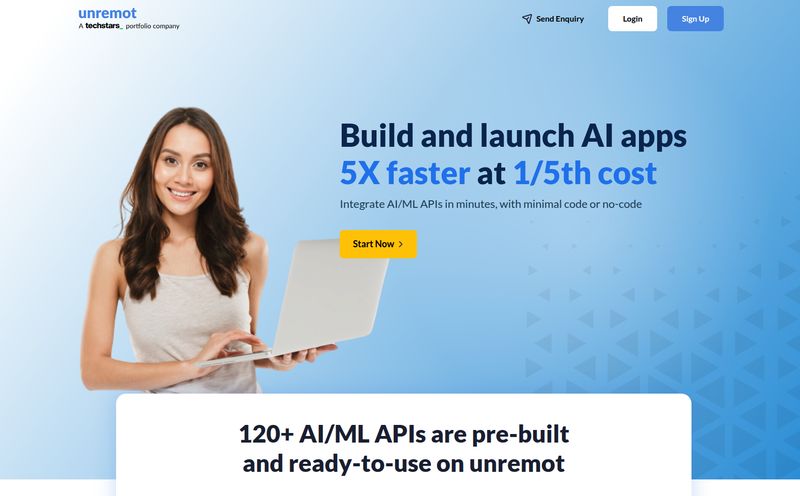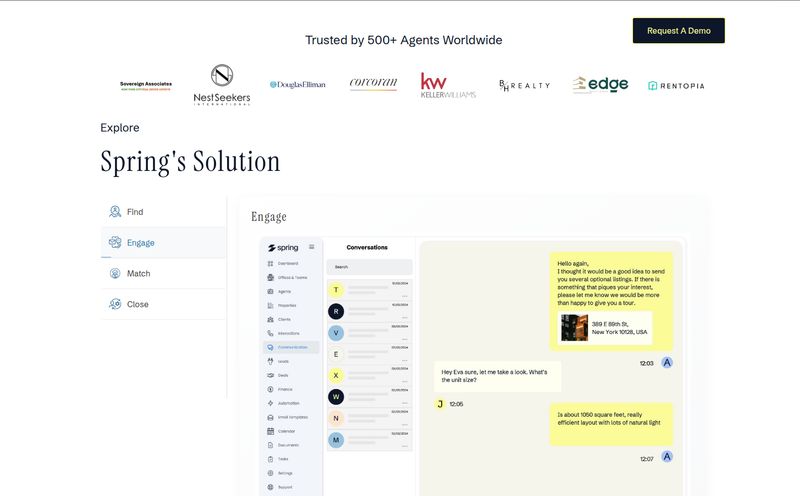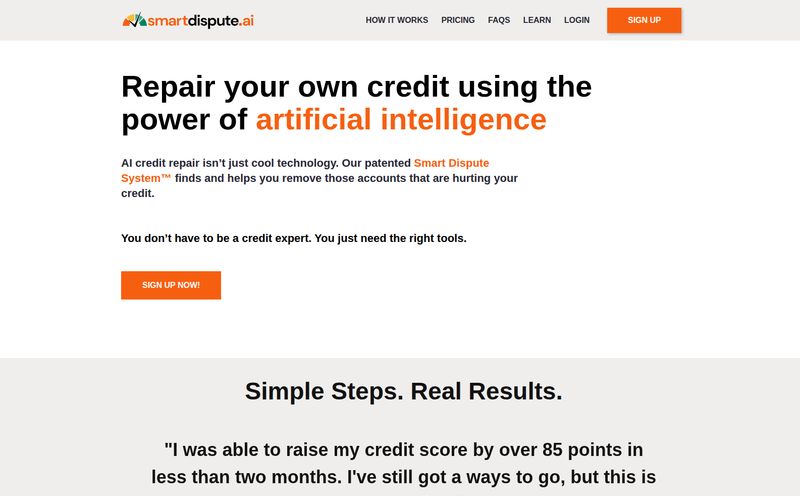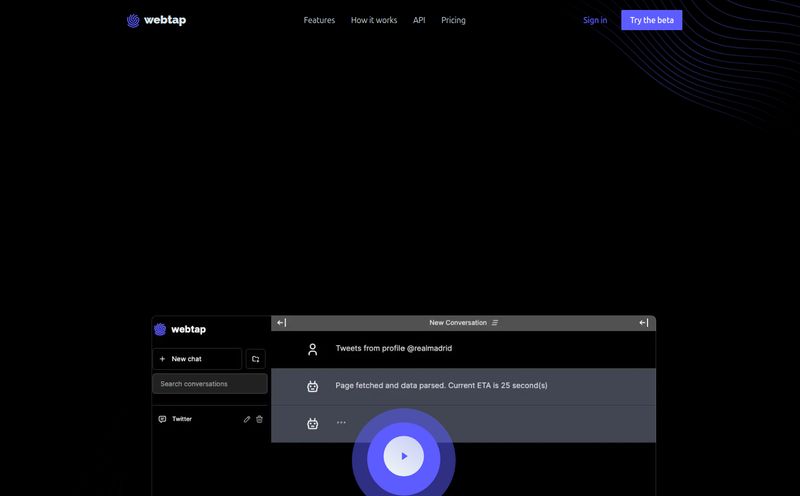For most of us in the SEO and marketing world, the phrase “web scraping” brings on a mild sweat. It’s this powerful, almost mythical thing that developers do. We know we need the data—competitor prices, product descriptions, lead lists—but the thought of wrestling with CSS selectors, XPaths, and IP blocks is enough to make you just... not do it. We've all been there, right? Staring at an 'inspect element' window, feeling like we're trying to defuse a bomb in a language we don't speak.
So when a tool like ScrapeComfort pops up on my radar, claiming “effortless” and “pain-free” data scraping using AI, my inner skeptic raises a well-groomed eyebrow. I've heard these promises before. But this one felt a little different. It doesn't just promise to be easier; it promises to change the conversation entirely. Instead of learning the computer's language, you just... tell it what you want. In English.
Could this really be the tool that lets marketers and analysts finally get the data they need without begging for a developer's time? I had to find out.
What Exactly is ScrapeComfort?
At its heart, ScrapeComfort is a desktop application that acts as a ridiculously smart data-gathering assistant. It’s not some vague cloud platform with a confusing interface. You download it, you run it, and it uses your own browser (or their servers on paid plans) to go to websites and pull information.
The secret sauce? It’s hooked into ChatGPT. This is the big shift. Instead of you needing to pinpoint data with surgical precision like div.product-info > h2.title, you just tell it: “Get me the product title.”
Think of it less like being a code-writing surgeon and more like being a manager with a very capable, very fast intern. You just point and say, “I need all of those from this list of pages, put them in a spreadsheet. Thanks.” That’s the dream, anyway.
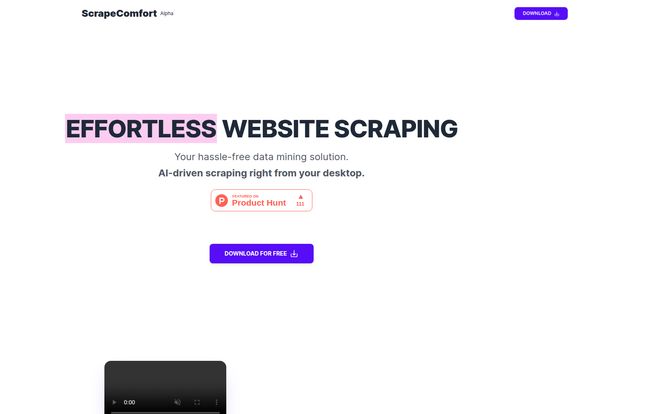
Visit Scrape Comfort
The Four-Step Process That Promises Simplicity
The whole workflow is designed around being straightforward. Their website breaks it down into four steps, and in practice, it really is that simple.
1. Getting Your URLs Ready
First, you need to tell it where to look. ScrapeComfort is pretty flexible here. You can paste a list of URLs directly, upload a CSV file, or even hook it up to a Google Sheet. For anyone doing ongoing competitor monitoring or SERP analysis, the Google Sheets integration is a nice little touch.
2. The AI-Powered Extraction
This is where the fun begins. Once you have your pages downloaded, you create an “extractor.” You give it a name, like “Product Price” or “Author Name,” and then you type a simple command describing what you want. For a blog, you might tell it to “extract the article’s main headline” or “get the publication date.” The AI interprets your command and finds the corresponding data on the page. It’s wild to watch it work, and it feels a bit like magic the first time it correctly pulls data without you lifting a finger to inspect an element.
3. Downloading and Saving Your Data
As the tool runs, you can see the progress. Once it’s done its thing, you’ve got options. You can copy the data to your clipboard—perfect for pasting directly into Google Sheets or an email. Or you can export everything into a clean CSV file, ready for some serious spreadsheet wizardry. No weird formatting, no messed-up columns. Just the data.
Who Is This Tool Actually For?
While developers might stick to their Python scripts, I see a few groups of people who would absolutely love ScrapeComfort.
- Marketing and SEO Managers: Imagine being able to pull the top 100 search results for a keyword and instantly grab the title tags, meta descriptions, and word counts for every single page. Without writing a single line of code. That's powerful stuff for competitor intelligence.
- Data Analysts & Researchers: Need to gather public opinion data, product reviews, or pricing information from a dozen different sites? This drastically cuts down on the manual 'copy-paste' part of the job, letting you get to teh actual analysis faster.
- Sales & Growth Teams: Building a list of potential leads from an online directory or conference attendee list? This is your new best friend. Just point it at the pages and tell it to grab the names, companies, and titles. (Just, you know, be a good human and respect the terms of service of the sites you're scraping).
The Good, The Bad, and The “Coming Soon”
No tool is perfect, and ScrapeComfort has its own set of quirks. After playing with it for a while, here's my honest breakdown.
The Great Stuff
The biggest win, hands down, is the no-code AI extraction. It’s a genuine game-changer that lowers the barrier to entry for data gathering. The fact that it also handles JavaScript-heavy websites is a massive plus, as so many modern sites are basically unusable for older, simpler scrapers. The simplicity is its greatest strength.
The Catches and Caveats
Now for the reality check. For the free plan, you need to bring your own OpenAI API key. This isn’t a huge deal if you’re a bit tech-savvy, and getting a key is easy, but it is an extra step and your usage will be billed against your OpenAI account (which is usually very cheap for this kind of task). It's a fair trade-off for a free tool, but one you need to be aware of.
The other thing is that the most exciting features—like scheduled jobs and cloud processing—are part of the paid plans, which are listed as “Coming Soon.” This means, for now, ScrapeComfort is a fantastic desktop utility for jobs you run manually. If you need a fully automated, set-it-and-forget-it cloud scraper today, you might have to wait.
A Look at the ScrapeComfort Pricing
The pricing structure is pretty clear and caters to different needs. I've always appreciated transparent pricing. Here’s how it breaks down:
| Plan | Price | Key Features |
|---|---|---|
| Free | $0 / month | Use your own browser & OpenAI key, data export, basic support. |
| Cloud (Coming Soon) | $15 / month | Uses their servers & AI, scheduled jobs, smart downloader. |
| Enterprise (Coming Soon) | $100 / month | Dedicated server, premium support, all Cloud features. |
The Free plan is genuinely useful for getting started and for smaller, one-off projects. The Cloud plan looks like the sweet spot for most professionals once it launches.
My Final Verdict on ScrapeComfort
So, is ScrapeComfort the answer to all our data scraping prayers? For many of us, I think it’s pretty darn close. It successfully removes the single biggest obstacle: the coding requirement.
It’s not trying to be the most powerful, complex scraping suite on the market. Instead, it's focused on making data extraction accessible. It’s a tool for the rest of us—the marketers, analysts, founders, and curious individuals who just want to get information from the web without a computer science degree. It's a massive step in the right direction, and I'm genuinely excited to see how it grows when the cloud features roll out. For now, it’s earned a permanent spot in my own digital toolbox.
Frequently Asked Questions
Do I need to be a developer to use ScrapeComfort?
Absolutely not. That’s the whole point. It’s designed to be intuitive for anyone, regardless of technical skill. If you can write a simple sentence describing what you want, you can use this tool.
Why do I need an OpenAI API key for the free version?
The free plan uses your personal OpenAI account to power the AI-based extraction. This allows ScrapeComfort to offer the core functionality for free, while the (typically small) cost of processing is handled by your own OpenAI credits. The paid plans will use their own specialized AI, so you won't need a key.
Is my OpenAI key shared or stored insecurely?
According to their site, the key is stored locally on your machine and is only used to communicate directly with OpenAI's servers. It's not shared with ScrapeComfort's servers, which is a good security practice.
What kind of data can I pull with this tool?
Pretty much any visible text-based data on a website. Think product names, prices, reviews, article headlines, contact information, stats, social media handles... if you can see it and describe it, ScrapeComfort can probably grab it.
How do I get an OpenAI key?
You can get one by creating an account on the OpenAI Platform website. You'll need to go to the API keys section and generate a new secret key. Just copy and paste that into ScrapeComfort.
Can it scrape sites that require me to log in?
Since it uses your local browser instance, it should be able to work with sites you're already logged into. You'd just log in to the site in Chrome as you normally would, and then run the scraper, which would operate within that logged-in session.
Conclusion
Web scraping has always felt like a members-only club for developers. ScrapeComfort is the friendly bouncer that waves everyone else in. It’s a smart, practical tool that democratizes data extraction by focusing on natural language instead of code. While it's still in its early days with more features on the horizon, what’s here today is already incredibly useful. If you’ve ever wished you could just ask a website for its data, I’d say give the free version a download. You might be surprised at how comfortable it feels.
